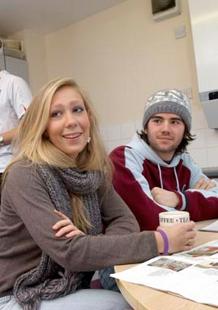Multimodality: language and the body
Aims
Aims
Most of our language use and acquisition happens through face-to-face interaction, which gives us access not only to what we and others say, but also how we use our bodies in interacting with others. A growing area of research explores how language is connected to gesture, facial expression and eye gaze: how are multiple channels of information like lexical choice, syntactic structure, intonational structure, and other aspects of linguistic production connected to the use of the body as we talk? How do we interact with one another and with objects in a physical world? How does this shape our language, and how does our language reflect the demands of being human beings in bodies, and in a physical world? In this module, we explore language as a multimodal phenomenon, grounding our work in everyday interactions, and using the methodological resources of conversation analysis, gesture studies, and phonetics.
At the end of this module you will be able to:
- recognise the different modalities that are relevant for language use in spoken face-to-face interaction, including: facial expression, manual gestures, phonetic production, eye gaze;
- use appropriate software to study visible bodily actions, including gesture and speech;
- be able to annotate and transcribe spoken and visible/gestural behaviours using standard transcription methods;
- write about a problem in face-to-face interaction, drawing on technical skills, and showing an appreciation of some of the debates around the topic.
You will know:
- various ways in which speakers use language and the body together as resources for meaning and action in face-to-face interaction;
- major theories developed to account for specific modalities such as facial expressions, manual gesture, speech and eye gaze;
- important empirical studies conducted on specific modalities and their coordination with language production.
Co-requisites
Co-requisites
This module would work well with phonetics modules, such as Articulatory & Impressionistic Phonetics or The Prosody of English; or The Language of Turn and Sequence (audit).
Programme
Programme
Contact hours
There are three contact hours a week, in two streams: one is a lecture/seminar stream, the other a practical stream.
Lecture/seminar stream
Four topics will covered in two-week blocks. Lectures and seminars will be in alternate weeks (lecture one week, related seminar the next), and each two-week block will focus on a particular topic. The lecture will provide an overview of the main issues both in the literature and where there are gaps in current knowledge. The seminar will pick up issues from the lecture and will involve discussion of reading materials, exercises with data, and critical examination of the topic.
Practical stream
The practicals will be lab-based. They will require students to do some preparation and/or follow-up. They will run weekly for one hour. They will cover how to use appropriate software, and the analysis of data.
Teaching programme
Practical stream
The practicals will cover the following topics:
- ELAN (software for the analysis and annotation of video data)
- Making suitable data extracts
- Making collections of comparable extracts for the purposes of analysis
- Practicalities and house-keeping while working with digital data: making video clips, file formats, saving data, etc.
- Annotation of data in ELAN and Praat; importing/exporting between these programs and others, including annotation files
- Transcription of data for presentation, using standard schemes for conversational data: Mondada’s scheme for multimodal transcription, GAT2 for prosodic features
Content
The content in the spring term will cover important topics in the analysis of face-to-face spoken interaction. The precise content will vary from year to year, but is likely to include:
- Foundations of multimodality (including the relations between spoken and signed languages, and the place of gesture)
- Gaze: its alignment to other events in interaction, its use in turn construction and the formation of social actions
- Manual gesture: its alignment to other events in interaction, its internal structure, and its relation to language production and processing
- Facial expression, including relations with prosodic features in the construction of turns at talk
Teaching materials
TBC
- Bavelas, J. B., Chovil, N., Lawrie, D. A., & Wade, A. (1992). Interactive gestures. Discourse Processes, 15, 469-489.
- Enfield, N. J. (2009). The Anatomy of Meaning. Cambridge: Cambridge University Press.
- Kendon, A. (2004). Gesture. Visible Action as Utterance. Cambridge: Cambridge University Press.
- Mondada, L. (2016). Challenges of multimodality: Language and the body in social interaction. Journal of Sociolinguistics, 20(3), 336–366. http://doi.org/10.1111/josl.1_12177
Assessment
Assessment
Formative work
- two 1000 word essays
Summative assessment
- one 5000 word essay

About this module
- Module name
Multimodality: language and the body- Course code
L77M (LAN00077M)- Teacher
Richard Ogden, Kobin Kendrick- Term(s) taught
Spring- Credits
20
